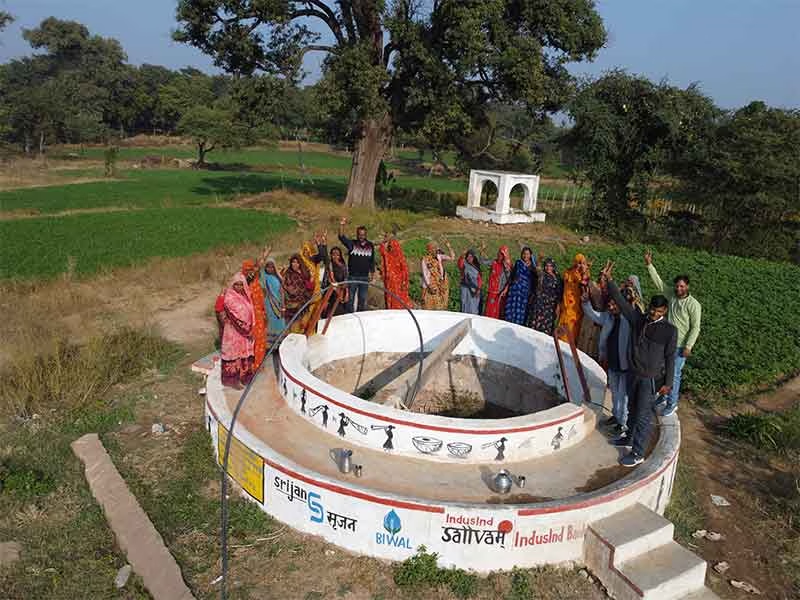
Heat waves have been intensifying over vast areas of India in recent days and there are also many reports of water scarcity making the conditions worse for people. However the situation can differ significantly in various villages depending on whether or not significant water conservation efforts have been made. In recent years I have visited several villages of good water conservation efforts where I noticed that even at the time of adverse weather conditions, people of these villages as well as farm and other animals feel important relief in terms of access to adequate water. Due to water and moisture conservation, conditions of farms and pastures is also much better. What is more, with the participation and involvement of people, even quite low budgets have been utilized well to achieve very useful and durable results.
One village I particularly remember is because of the great enthusiasm and happiness I saw among the people, particular women, due to the recently taken up water conservation efforts which had improved their life in a very significant ways. This is Markhera village of Tikamgarh district (Madhya Pradesh) in Central India. People of this village had been facing increasing difficulties due to water shortages. Water table was declining and water level in wells was going down too. Hand pumps were often reduced to just a trickle. As women here bear most water related responsibilities, their drudgery in fetching water from more distant places increased. Many of them had back ache from drawing water which was too low down in wells.

It is in this condition that a social activist named Mangal Singh contacted villagers. He told them that the organization he belonged to (SRIJAN) had a program of digging saucer shaped structures in water courses or seasonal water flows so that some of the rain water would remain in them for a much longer time for the dry season. As this is exactly what the villagers needed, they agreed readily.
When this work was taken up, villagers could also take the silt that was taken out and they carried it away for bund construction in their fields. The main benefit from the conservation of water in the newly constructed structures, called dohas, started being visible all too soon. Soon the demand for more dohas upstream and downstream came up. These benefited more and more farmers including those in neighboring villages.
While this work was being taken up the activists developed a closer relationship with the community and together they reached an understanding that to get fuller benefits, several broken structures, like check dam gates, of water conservation work taken up by the government in the past also needed to be repaired. Here again the initial results were so encouraging, with substantial benefits of increased water availability resulting from an expenditure of just INR 20,000 (about 250 US dollars) at one repair site, that there were demands for repairing other structures upstream and downstream of this. When this work was also completed, the water scene of the village changed from one of acute scarcity to abundance.
As I learnt from several villagers, many more farmers are now able to irrigate their farms properly and crop yield has increased for several of them by about 50% or so. Some of them are able to take an additional crop as well. The water level in wells and hand-pumps has risen so that drinking water too can be obtained more easily. Women do not have to spend much time in getting essential supplies of water, nor do they have to take up very tiring work. It has even been possible to obtain the water needed for creating a beautiful forest, not far from the water course and the main repair work site, which in turn would also contribute to water conservation. As a young farmer Monu Yadav said, the benefits have been many-sided and far reaching. One of the less obvious but nevertheless important gains in fact relates to increased cooperation for tasks of common benefit. As the benefits of dohas would be lost after a few years if these are not cleaned and not maintained properly, groups of farmers have been formed with farmers closest to a doha being made collectively responsible for maintenance work.
Such small-scale water conservation work can be very cost effective. The entire work of repairs and pits at this place has cost just around INR 400,000 (about 5000 US dollars) or so while many-sided and durable benefits have spread to several villages. In fact in its entire planning for water conservation work SRIJAN has emphasized low-cost works such as doha pits as well as repair and renovation of already existing structures. In neighboring Niwari district, the experience of dohas dug in Gulenda village water-channel has been particularly encouraging.
Another benefit of such small scale water conservation works is that in such cases the prospects of involving the community in planning and implementation and benefitting from their tremendous knowledge of local conditions are immense and therefore such small water conservation schemes are invariably more creative and successful compared to big, costly, centralized ones.
Till just about five years ago, in Nadna village of Shivpuri district (Madhya Pradesh) the situation for most households was quite distressing. As several women of this village related recently in a group discussion, most of the rainwater rapidly flowed away from the village quite rapidly on sloped land, leaving hardly anything for the longer dry season ahead and contributing very little to water recharge. What is more, on the sloped land the rapid water torrents carried away a lot of the fertile topsoil as well.
With all the rainwater being lost quickly and even carrying away fertile soil, the farm productivity in the village was very low, and in fact very little could be grown in the season devoid of monsoon rains. Some of the land even remained uncultivated. In this village located in Pichore block, water scarcity remained a constraint not just for farming but also for animal husbandry. Not just villagers and their animals, but wild life also suffered due to water scarcity.
Due to low development prospects in farm and animal husbandry based livelihoods, people of this village, particularly those from poorer households, were becoming heavily dependent on migrant labor. The work which most of the migrants from here could get was frequently exploitative and also uncertain, but due to lack of alternatives, villagers had to resort to this as a survival mechanism despite all the distress and difficulties they suffered.
However about four years back a number of water conservation steps were initiated in this village. These included the creation of bunds and digging of small ponds in fields and construction of a gavian structure to keep a good part of rainwater in the village. In the two nullahs which drain the rainwater, about 80 spots were selected in consultation with the local villagers for digging dohas.

All this helped to conserve rainwater at many places but in addition also increased the overall water level in the village and its wells so that it has become possible to get more water more easily from wells and hand-pumps. Now farm animals as well as wild animals can find more water to drink even in dry months. Moisture conservation has resulted in the sprouting of more grass and related greenery, resulting in better grazing for animals.
At the same time, farm productivity has gone up. Now there is more cultivation of non-monsoon crops like wheat and in addition some of the land left more or less uncultivated earlier has also been brought under cultivation now. With soil erosion being checked too, soil quality is getting better. As a result of all this the dependence of villagers on exploitative migrant labor has reduced considerably.
The situation in Umrikhurd village in this district has also changed in a somewhat similar way, thanks to the digging of farm ponds and dohas as well as the creation of bunds in farms. An additional livelihood of pond fisheries has also emerged. As women related happily in a recent group discussion, now you can find water at several places where earlier it used to be dry by now.
These initiatives in the two villages of Shivpuri district were taken up by SRIJAN voluntary organization with support from Axis Bank Foundation and IndusInd Bank.
The trust and involvement of these communities is also evident from their willingness to contribute their share of voluntary work as well as some economic resources.
In many villages of Bundekhand region of Central India, SRIJAN implemented a special program called BIWAL (Bundelkhand Initiative for Water, Agriculture and Livelihoods), also involving other leading voluntary organizations of the region in its implementation. In this initiative water conservation has been well integrated to improvement of soil and increase of farm yield by mobilizing the village community for a simple program.
In Bundelkhand region, comprising 14 districts of Uttar Pradesh and Madhya Pradesh states, a very important contribution to water conservation has been made historically by well-constructed water tanks some of which go back to about 1000 years or even more. The ABV Institute of Good Governance has identified nearly 1100 such tanks. However several of them have become heavily filled with silt due to cleaning and de-silting work having been neglected for years. In this situation SRIJAN offered to arrange the de-silting work while farmers volunteered to carry away the mounds of highly fertile silt taken out from the tanks to their fields. As silt was taken out, the capacity of tanks to retain more rainwater increased. As more fertile silt was deposited in farms, the chances of making a success of natural farming, without using chemical fertilizers, increased. Hence both the tasks of water conservation and farm improvement were well integrated. While SRIJAN and Arunodaya organizations initiated this work in Baura village of Mahoba district (Uttar Pradesh), a community organization was formed to take this forward and later the community came forward to take to take up the de-silting work on its own.
This approach was particularly useful in Karauli district (Rajasthan) where in the rocky land of Makanpurswami village, deposition of a lot of fertile silt led to many acres of unproductive land becoming cultivable, again providing a great example of linking water conservation and improvements in farming. Here the villagers had initiated water conservation work on their own but the arrival of SRIJAN helped and motivated them to take it up on a much bigger scale.

In Teen Pokhar village land and soil conditions are difficult and wild animals also disrupt farming, but several farmers are hopeful even in these difficult conditions as SRIJAN and other voluntary organizations have created several new pokhars or ponds in the village apart from repairing earlier ones. Several of these are linked to each other so that excess of one can flow to another. In Rawatpura village of this district, the once difficult situation is now looking even more hopeful as the creation of several new ponds has made it possible to take farming to more and more land that could not be cultivated earlier.
These are examples of villages where proper utilization of relatively quite low budgets led to very significant improvements in water conservation, bringing many-sided benefits to villagers and in some cases changing the situation of villagers from despair to hope. These achievements of water conservation are also very useful in terms of contributing to climate change adaptation.
Subscribe to Our Newsletter
Get the latest CounterCurrents updates delivered straight to your inbox.
Bharat Dogra is Honorary Convener, Campaign to Save Earth Now. His recent books include Man over Machine, Protecting Earth for Children, Planet in Peril and A Day in 2071.













































